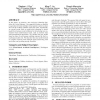Free Online Productivity Tools
i2Speak
i2Symbol
i2OCR
iTex2Img
iWeb2Print
iWeb2Shot
i2Type
iPdf2Split
iPdf2Merge
i2Bopomofo
i2Arabic
i2Style
i2Image
i2PDF
iLatex2Rtf
Sci2ools
ATAL
2010
Springer
2010
Springer
Modeling collision avoidance behavior for virtual humans
In this paper, we present a new trajectory planning algorithm for virtual humans. Our approach focuses on implicit cooperation between multiple virtual agents in order to share the work of avoiding collisions with each other. Specifically, we extend recent work on multi-robot planning to better model how humans avoid collisions by introducing new parameters that model human traits, such as reaction time and biomechanical limitations. We validate this new model based on data of real humans walking captured by the Locanthrope project [12]. We also show how our model extends to complex scenarios with multiple agents interacting with each other and avoiding nearby obstacles. Categories and Subject Descriptors I.2.11 [Distributed Artificial Intelligence]: Multiagent systems General Terms Algorithms, Experimentation, Verification, Performance Keywords Human Motion, Collision Avoidance, Virtual Agents, Simulation, Robotics
ATAL 2010 | Humans Avoid Collisions | Intelligent Agents | Multiple Virtual Agents | Virtual Agents |
Related Content
| Added | 08 Nov 2010 |
| Updated | 08 Nov 2010 |
| Type | Conference |
| Year | 2010 |
| Where | ATAL |
| Authors | Stephen J. Guy, Ming C. Lin, Dinesh Manocha |
Comments (0)

